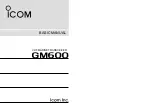
Spektrum AR9200
11
Spektrum AR9200
12
Mounting the Remote Receivers (continued)
• Fuel tanks
• Metal bypass tubes
• High-temperature components like exhaust systems
• Any significant metallic conductive components
• High-vibration areas
The remote antennas should be mounted a minimum of at least 2” apart
from each other as greater antenna separation gives improved path
diversity (RF link performance) in critical environments. In large aircraft
where space is not an issue it is highly recommended that the antennas
be mounted throughout the aircraft as illustrated. Spektrum offers remote
receiver extensions ranging from 6” to 36” allowing the receivers to be
mounted in the most optimum locations throughout the aircraft.
Using double-sided foam tape and tie wraps, mount a minimum of 3
remote receivers in your aircraft as per the illustrations and plug them into
the receiver ports.
The following are illustrations of typically recommended installations.
Note the remote receiver orientation.
• 35% aerobatic plane with single NiMH battery and three remote
receivers
• 35% aerobatic plane with dual NiMH batteries and three remote
receivers
Mounting the Remote Receivers
• 40% aerobatic plane with dual LiPo batteries and three remote receivers
• Jet with dual LiPo batteries and three remote receivers
Antenna Polarization
For optimum RF link performance it’s important that the remote antennas
be mounted in an orientation that allows for the best possible signal
reception when the aircraft is at all possible attitudes and positions.
This is known as antenna polarization. This allows the greatest exposed
visual cross section of the antennas from all aircraft orientations. It is
recommended that one antenna be mounted vertically, one horizontally
in-line with the fuselage and one horizontally perpendicular to the fuselage
(see illustrations on pages 11-12). This covers the X,Y and Z axis offering
superb cross section visibility in all aircraft orientations.
Locating the Remote Receivers
While Spektrum 2.4GHz systems are far more resistant to interference
caused from internal RF generating sources, the remote receivers should
be mounted as far away as practical (typically 4” or greater if possible)
from the following:
• Ignition systems
• Ignition batteries
• Ignition switches
• Engines
• ECU’s pumps
• Electric motors
• Receiver batteries
































